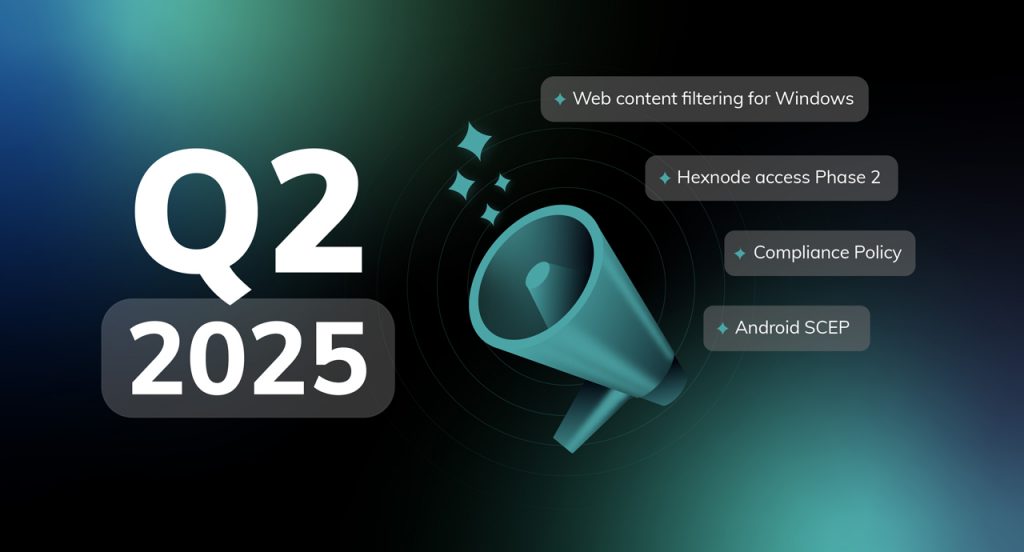Hexnode Access for Windows: Here’s what you need to know
Hexnode Access for Windows simplifies device security with seamless cloud IdP logins. Learn key setup tips and IT benefits.

Get fresh insights, pro tips, and thought starters–only the best of posts for you.
Isla Adams
Jul 17, 2025
7 min read

We’re halfway through 2025 already—but here at Hexnode the newest updates are just the beginning of what’s next. From smarter workflows to fresh ways of keeping your devices secure, this quarter’s updates set the tone for a packed second half of the year.
On July 16th, 2025, at 10:00 AM CDT, we hosted our latest session, sharing feature highlights, live demos, and even a sneak peek at what’s next.
Certificate-based authentication just got a whole lot easier for Android. With SCEP (Simple Certificate Enrollment Protocol) support now live, IT teams can issue and manage certificates at scale, enabling secure access to enterprise Wi-Fi, VPNs, and other protected services—no more user-managed passwords or manual installs.
This update makes certificate management fully automated. Through Hexnode’s policy-based deployment, devices can now request, renew, and even revoke certificates without admin intervention. It’s a zero-touch process designed to save time and reduce errors.
For organizations with strict compliance needs, SCEP also helps enforce certificate-based authentication in line with regulatory standards like HIPAA, GDPR, and ISO.
Hexnode’s Built-in reports just got a visual upgrade. You can now switch between traditional tables and sleek bar graphs or pie charts, making it easier than ever to spot trends, catch anomalies, and understand key metrics at a glance.
Whether you’re tracking device distribution, monitoring user activity, or keeping an eye on compliance, these new visualizations turn rows of data into actionable insights. You can even add up to four graphs per report, customizing views based on the attributes that matter most to you.
Hexnode now extends web content filtering to Windows devices, giving IT admins more control over what users can access online. With this feature, organizations can block access to non-work-related or unsafe websites and enforce acceptable use policies across their device fleet.
Admins can set up filters by blocklisting unwanted URLs or allowlisting trusted ones. Whether it’s restricting social media during work hours, protecting against phishing and malware sites, or tailoring access rules for different roles and departments, policies can be customized to fit every use case.
The filtering works seamlessly across major browsers, like Microsoft Edge, Google Chrome, and Mozilla Firefox, ensuring consistent enforcement regardless of how users browse. Once applied, attempts to visit restricted sites will trigger a warning that the organization has blocked access.
Managing Android Enterprise enrollments just got more secure and flexible. Hexnode’s new enrollment restrictions give IT admins granular control over which devices can join the corporate ecosystem.
With these controls, admins can allow only approved device manufacturers like Samsung, Zebra, or Honeywell, enforce minimum Android OS versions, and even restrict enrollments to pre-approved devices. For added security, IP whitelisting ensures devices can only be enrolled from trusted networks, and admins can cap how many devices each user is allowed to register—perfect for keeping license usage in check.
Hexnode’s Compliance Policies let you define what a “secure device” looks like and enforce those standards across your fleet. With two levels of rules, you get the flexibility to keep things simple or go deep:
If a device fails to meet these standards at any point in its lifecycle, it’s automatically marked non-compliant. From there, IT can view details, trigger alerts, or even restrict access to protect corporate data.
Logging in to Windows devices just became a whole lot easier. Hexnode Access now supports Okta as an identity provider, letting users sign in with their existing Okta credentials alongside Microsoft Entra ID and Google Workspace.
This update doesn’t stop there. Password synchronization ensures local Windows passwords stay in sync with cloud accounts, cutting down forgotten passwords and IT support requests. And to keep compliance simple, admins can now distribute End User License Agreements (EULAs) during device setup—making sure users accept critical policies from the very first login.
Hexnode now brings support for managed guest sessions on ChromeOS, making it easy for organizations to securely share Chromebooks without requiring users to sign in with personal Google accounts.
Perfect for kiosks, libraries, retail floors, and other shared-use environments, this update lets IT teams configure everything from the user interface and accessibility options to printing, power management, and remote access. Admins can fine-tune session behavior—like showing or hiding the bookmarks bar, setting the shelf position, restricting developer tools, or enabling Google Translate—ensuring a consistent, secure, and user-friendly experience for every guest session.
And that brings us to the end of this quarter’s updates. Before we wrap up, here’s a quick look at what’s lined up for the next WNWH session:
Stay tuned—there’s plenty more in store to make managing devices even simpler.
That’s all from this quarter’s WNWH session. With new updates and enhancements across the board, there’s plenty to check out in your Hexnode console.
Missed the live session? No worries—the full webinar recording is ready for you to check out anytime.
We’ll be back with another round of updates next quarter. See you then!
Try out Hexnode's 14-day free trial to manage all your endpoints
Sign up now